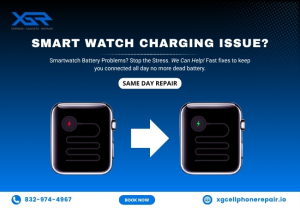Having your phone stop charging unexpectedly can be frustrating, especially when you’re in a hurry or rely on your device for communication. Whether you’re using an iPhone or an Android phone, charging issues can arise for a variety of reasons, from faulty charging ports to software glitches.
If you’re struggling with your phone not charging, you’re not alone. This common issue can be caused by several factors, and understanding how to troubleshoot the problem can save you time and money. In this guide, we’ll walk you through the most common reasons your phone might not be charging and provide actionable steps to fix the issue.

Common Reasons for Phone Not Charging
Before diving into the troubleshooting tips, it’s important to understand the possible causes behind why your phone isn’t charging. Knowing the root of the issue will help you find the most effective solution.
Here are some common reasons why your phone may not be charging:
1. Faulty Charging Cable
A damaged or frayed charging cable is one of the most common reasons for charging issues. Over time, cables can get worn out from constant bending, pulling, or physical stress.
2. Dirty Charging Port
The charging port on your phone can accumulate dirt, dust, or lint, which can obstruct the connection between your phone and the charging cable. A dirty charging port is often overlooked but can cause major charging issues.
3. Software Problems
Sometimes, your phone’s software might be the issue. Software glitches, bugs, or updates can cause charging problems by interfering with how your phone recognizes the charging process.
4. Broken or Faulty Adapter
The adapter (the part you plug into the wall) can also malfunction over time. If the adapter is faulty, your phone may not receive a charge, even if the cable and charging port are in good condition.
5. Battery Issues
If your phone’s battery is damaged or old, it may no longer hold a charge properly. In such cases, the issue isn’t with the charging process but with the battery itself.
6. Overheating
Phones often stop charging when they get too hot. Overheating can happen if you’re using your phone while charging, or if it’s exposed to extreme temperatures.
7. Power Source Issues
The wall outlet, power strip, or USB port you are using to charge your phone could be faulty. It’s important to rule out any issues with the power source before troubleshooting the phone itself.

Step-by-Step Troubleshooting Tips for Fixing Phone Not Charging Issues
Now that we’ve covered the potential causes, here are some simple and effective troubleshooting steps you can take if your phone is not charging. These steps work for both iPhones and Android phones, but always consult your manufacturer’s instructions for specific advice.
1. Try a Different Wall Outlet
One of the simplest things you can do when your phone isn’t charging is to check the power source. Wall outlets can sometimes fail, and the problem might not lie with your phone or charging equipment.
- Action Step: Plug your charging adapter into a different wall outlet, ideally in a different room. This will help you determine if the issue lies with the outlet, charger, or your phone itself.
2. Inspect the Charging Cable
Your charging cable is another potential culprit in charging problems. Even minor damage to the cable can prevent your phone from charging properly. Look for any signs of fraying, cuts, or wear.
- Action Step: Inspect the cable for any visible damage. If you notice any issues, try using a different cable to charge your phone. Borrowing a cable from a friend or family member can help you quickly identify whether the cable is the problem.
3. Check the Charging Port for Dirt or Debris
The charging port on your phone can collect dirt, dust, and lint, preventing a solid connection between the cable and your phone. This is a common issue that many users overlook.
- Action Step: Use a flashlight to inspect the charging port for any visible dirt or debris. If you see any, gently clean the port using a soft brush, toothpick, or a can of compressed air. Be very careful not to damage the port while cleaning it.
4. Test the Charging Adapter
The charging adapter, which connects the cable to the wall outlet, could also be the source of the issue. If the adapter is broken or faulty, your phone won’t charge, even if everything else is working fine.
- Action Step: Test the adapter with another device or try using a different adapter to see if your phone charges. If you find the adapter is faulty, replacing it should solve the problem.
5. Let Your Phone Charge for a While
If your phone has been completely drained, it might take a while before it starts charging again. Sometimes, a completely dead battery won’t show any sign of life immediately after being plugged in.
- Action Step: Leave your phone connected to the charger for at least 30 minutes to an hour. If the battery is completely dead, the phone might take longer to recognize the charging process.
6. Restart Your Phone
Just like computers, phones can experience software glitches that interfere with their performance. Restarting your phone can often solve minor software issues that prevent charging.
- Action Step: Turn off your phone, wait a few seconds, and then turn it back on. This simple step can clear temporary software problems that might be affecting the charging process.
7. Update Your Phone’s Software
If the charging issue is caused by a software glitch, it may be resolved with an update. Operating system bugs or outdated firmware can sometimes cause problems with charging.
- Action Step: Check for any available software updates by going to your phone’s settings. If an update is available, install it and see if the charging issue is resolved.
8. Check for Overheating
If your phone gets too hot while charging, it may stop charging to protect itself. Overheating can be caused by using the phone while it’s charging, or by having the phone exposed to excessive heat.
- Action Step: If your phone feels hot, unplug it and let it cool down for a few minutes before trying again. Ensure you’re not using your phone while it’s charging, as this can generate additional heat.
9. Consider the Battery Health
If your phone is several years old or you’ve been experiencing rapid battery drain, the issue might be with the battery itself. Lithium-ion batteries degrade over time, and if yours is no longer functioning correctly, it could prevent your phone from charging.
- Action Step: If none of the above solutions work, you may need to replace your phone’s battery. Contact your device’s manufacturer or visit a certified repair shop to assess the health of your battery.
10. Contact a Professional Repair Service
If your phone still isn’t charging after trying all these steps, it’s time to seek professional help. The problem could be more complex, such as a broken charging port or internal hardware failure.
- Action Step: Take your phone to an authorized service center or a certified repair shop. They will have the tools and expertise to diagnose and fix the problem.
Preventing Future Charging Issues
Once you’ve fixed the issue and your phone is charging again, it’s important to take steps to prevent future charging problems. Here are a few tips:
Charge Your Phone Regularly: Don’t let your battery drain to 0% too often. Try to keep it between 20% and 80% for optimal battery health.
Use Original or Certified Accessories: Always use the charging cable, adapter, and accessories that came with your phone, or certified third-party options.
Keep the Charging Port Clean: Regularly clean the charging port to avoid the buildup of dirt or lint.
Avoid Overheating: Don’t use your phone while it’s charging, and avoid charging it in extremely hot environments.

Conclusion
When your phone isn’t charging, it’s easy to jump to conclusions and assume the worst, but many charging problems can be fixed with simple troubleshooting steps. By following the tips outlined above, you can quickly identify and resolve the issue, whether it’s a problem with the charging cable, the adapter, or the phone itself.
If none of these steps work, it may be time to replace your battery or visit a professional repair service. In the meantime, remember to regularly clean your charging port and use certified accessories to avoid future problems.
Still have questions or concerns? Feel free to reach out to us in the comments below or contact a certified repair service for expert assistance.



